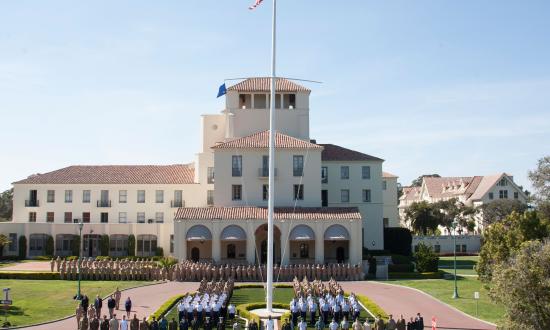Warfare is always changing, sometimes gradually and sometimes dramatically, as technology disrupts past practices and doctrine. Machine guns, aircraft carriers, tanks, nuclear weapons, precision munitions, and other systems have all shaped how past wars have been fought. But today, driven by technological advances, warfare is becoming dramatically smaller, smarter, faster, and closer. The marriage of these new technologies with smart, innovative, ethical, and strategic decision makers will disrupt tomorrow’s fight.
To maximize the effectiveness of this new era of technological innovation, the fundamental changes in the science of warfare should drive changes in both the content and delivery of education at professional military education institutions across the Department of Defense. Our students are the future leaders, and we need to educate them to understand how conflict is evolving; how to operate when adversary capabilities are changing rapidly; and how to leverage the changing nature of war to be smarter, faster, and better.
Smaller
From small, irregular units fighting enemy occupiers, to small cells of terrorists or even lone wolves, from individual hackers, to small boats swarming enemy ships, the unit of action is getting smaller. The use of unmanned vehicles (i.e., drones)—usually smaller and cheaper than manned systems—further expands the destructive footprint of war. The drone attack on the Abqaiq oil fields highlights the ability of relatively small platforms to produce outsized impacts at the strategic level.
This is not a phenomenon relegated to terrorists or irregular warfare; it is a change in warfare more broadly. Current developments in nanotechnology are literally shrinking the platforms that deliver the violence of war to minuscule levels. At some point in the near future, microscopic weapons will be capable of delivering biological or nuclear payloads. Michael Crichton’s Prey, or Black Mirror’s “Hated in the Nation” are no longer an improbable distant future. Increasingly, the destructive power will not come from single large platforms such as aircraft carriers, but from hundreds or even thousands of smaller platforms coalescing into a unified force. Armored divisions of tanks will look more like swarms of autonomous vehicles than the great battles of World War II.
Smarter
Warfare is being fought by ever-smarter allies and adversaries. States and nonstate actors alike learn from their past experiences and from the successes and failures of others. Adversaries adapt their strategies and tactics. Hezbollah and Hamas, for example, continue to evolve and escalate their use of tunnels against Israel. Likewise, China has developed new weapons and strategies specifically targeted against traditional U.S. naval assets and strike groups. Adversaries are getting smarter about negating the U.S. battlefield advantages. The U.S. military must accelerate its ability to get smarter in this competitive learning process.
Technologically, developments in artificial intelligence and machine learning are inexorably pushing more and more decision-making to computers. In many cases, these systems are better equipped to make the “right” decision than a human. Advances in augmented reality, virtual reality, 5G wireless connectivity, and wearable mobile devices are creating opportunities for greater situational awareness for commanders in the field. Knowing where the enemy is—and where your own forces are—has always been critical to success in war. We are entering an age when uncertainty about an enemy’s position, capability, and intent can be substantially reduced by these technologies. Increasingly, wars will be won not by who can bring the greatest accumulation of military assets to the fight, but by who uses their assets in the most strategic and unexpected ways. Learning faster, thinking better, and knowing more will be the key to winning future wars.
Faster
The speed of warfare is becoming ever faster. Information that once took days or weeks to share globally is now being shared in minutes and seconds. Conflicts that might have slowly simmered on the periphery now explode onto the international stage in mere moments because of the proliferation of social media. The ability to frame the narrative and set conditions for naval action depend on acting faster than the adversary. In this area, adversaries can shape the informational environment well before the first Marine or soldier sets foot on the ground. The luxury of time to build up forces is a distant memory from conflicts such as World War II or even the First Gulf War.
In the last century, the radio, aircraft, and the internal combustion engine radically transformed the tempo of warfare. With satellite communication, 5G networks, wifi, and broadband, the flow of information is faster than ever. The decision space for commanders based on that accelerating flow of information is shrinking fast. As a result, there is an even greater imperative to devolve operational command and control down to the lowest level possible. As General Stanley McChrystal reflected, “When I took over [the Joint Special Operations Command] I was approving every mission because I’m the commander, and I found there’s no way you can be fast enough, so my role changed” (emphasis added). Technologically, weapon systems from hypersonic missiles to offensive cyber attacks are increasing the speed of conflict.
This acceleration provides a marked advantage to the attacking force over the defender. As we have seen in history (World War I as a prime example), when technology favors the offense, defense is hard, deterrence is less likely to succeed, and conflict is more likely to arise from bolts-out-of-the-blue surprise attacks that can destroy enemy forces before they can respond in kind. Even when the defender is able to overcome the disadvantage of speed, seizing the initiative comes at ever higher levels of cost in blood and treasure.
Closer
Warfare is becoming closer. There are fewer and fewer frontlines in conflict. For centuries, the United States enjoyed the defensive advantage of two great oceans. Yet now, adversaries can bring the fight to the homeland. From attacks on critical infrastructure to attacks against our democratic processes, the defensive advantages of water and distance have diminished. With the increasing sophistication of cyber attacks, conflict is not necessarily even visible anymore. Countries target the cyber vulnerabilities of rivals; consider, for example, the Chinese attack on the Office of Personnel Management, the North Korean attack on Sony, and the U.S. cyber attack against Iran in retaliation of the attacks on the Saudi oil fields. In addition to cyber, adversaries are also becoming more adept at using proxy forces in places such as Syria and Ukraine to project power and leverage social media to conduct information campaigns to influence elections.
The greatest frontier, outer space, is no longer distant either. Space assets critical to national defense are now closer to the enemy. From GPS to surveillance satellites, U.S. vulnerabilities to the weaponization of space is forcing the country to rethink its reliance on these assets. Even the increasing range of conventional, kinetic weapons, is bringing conflict ever closer.
Education for Now
As warfare changes, so must the content of military education. Much has changed to the credit of many institutions, yet more is needed. As warfare becomes smaller, students need to study the design and operations of autonomous vehicles in the air, at sea, and on land, singly and in multidomain swarms. They need to study how adversaries have used and are using the seams in great power competition to exploit indigenous forces with small units of action, similar to how U.S. Green Berets toppled the Taliban in 2001. The Navy needs a robust learning environment focused on how technologies are shrinking weapon platforms and how that changes the art of what is possible for each side on the battlefield. It needs to develop leaders with the cognitive and technical tools to understand and exploit what was once too big to comprehend—masses of unorganized data—with new techniques from the fields of data analytics and data science.
As adversaries become smarter, students need to learn how those adversaries think and fight. Future military leaders need to be innovative on the battlefield, to be adaptive thinkers, and to anticipate the ethical ramifications of their decisions, because actions taken at the tactical and operational level will affect the level of national security policy. Students must be experts in how adversaries use artificial intelligence and machine learning and how to use that understanding operationally to achieve victory. Professional military education is not just studying dead Prussians or Civil War battles; it is understanding how forces have adapted to revolutionary changes in warfare and understanding the price of not innovating fast enough. We can no longer operate with curricula and programs that are exclusively focused on technology or policy and strategy; instead, future leaders need to learn and appreciate how technology and policy are inseparable.
As warfare becomes faster, students need to operate at the speed of relevance, cognitively and physically. Students must learn how to offload appropriate cognitive tasks to the automated systems so that they can concentrate on human-centered tasks, such as getting in their adversary’s head. As they gain speed cognitively, students must know how to project forces quickly to be able to fight at the critical place and time. Students need to understand how weapon systems are transforming the speed and logic of warfare. They need to understand how failed deterrence might lead to quick escalation and how their actions can create off-ramps for rapid de-escalation. All their activities will ultimately play out with the information domain accelerating and magnifying the speed of conflict. To be ready for that conflict, students must be able to speed up the U.S. acquisition process to deploy the new and innovative technologies before the need is critical.
As warfare become closer, students must study how social networks and social media, cyber operations, and information operations and strategies bring the fight to them, as well as how they might bring the fight to their adversaries. They must study other cultures and foreign areas to understand how U.S. forces might work with them. Students should understand that space is no longer a distant frontier and how it affects conflict close to home through communication systems, nuclear weapons, GPS, cyber assets, etc.
As emerging technologies change the nature of warfare, so, too, are they changing the opportunities for the delivery of education. We need to deliver education in smarter, more effective ways. Such delivery will involve more active-learning techniques, rethinking when educational opportunities are offered to military members and how to make the techniques relevant and useful to students returning to the operational force.
Commanders have long known that units require training even while deployed to maintain and enhance combat effectiveness. In the future, commanders will have to integrate education into their deployment plans to keep up with the rapidly changing operational environment. We need to make education more accessible by delivering smaller “chunks” of education at a time. We must bring education closer to where the students are, offering short expeditionary classes that leverage distance learning and personalized, adaptive learning technologies. Finally, we need to explore ways to adopt new educational practices faster. The Navy—indeed, all the armed forces— needs to be at the front of educational advancements, not at the back of the line. Ultimately, U.S. military education institutions must adopt an ethic of pedagogical and curricular innovation so that these institutions can always be on the cutting edge, delivering the most relevant educational content possible to the future leaders that are our students.
The most disruptive technology in the history of warfare has been the human mind. The Navy and the rest of the military need to prioritize developing this asset if it is to stay ahead of challengers.





